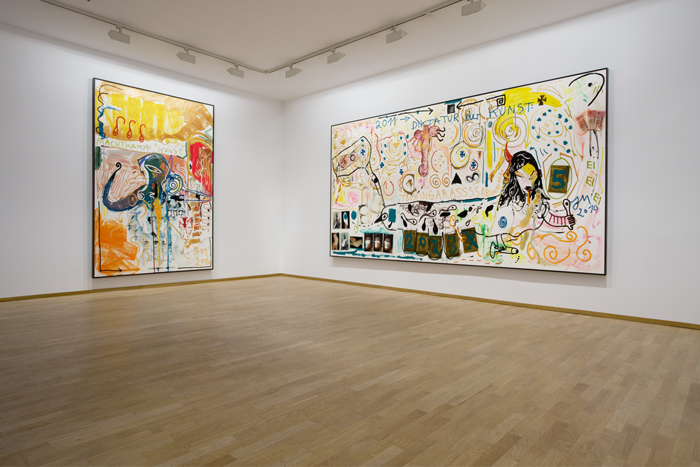Art Decides: Jonathan Meese in Paris

PHOTO BY JAN BAUER
Jonathan Meese’s work across painting, installation, and sculpture has for two decades negotiated a bi-polar mix of child-like references and violent protests against Germany history and contemporary media. Today, Meese, 40, still frequently wears his signature Adidas tracksuit, the uniform of an eternal teenage hood—but the Berlin-based artist can no longer qualify as an enfant terrible, nor can his work be summed up to sheer provocation.
His current show, “St Neutralité (TOTALES BALLETT DE LOLITADZIOZ),” at Galerie Daniel Templon in Paris, comprises painting and sculpture spread over two galleries. The wall works see a wider, lighter and more sensual palette composed, and a voluptuousness borrowed from Matisse. Yet these don’t proceed like some pastoral; instead, Swastikas and Wehrmacht crosses re-surface, an uncomfortable nudge at Germany’s role in World War II. He spoke about the work, sometimes in the third person.
ALICE PFEIFFER: Your show has been described as bearing resemblances to Matisse—do you agree? Do you feel this is a conscious decision?
JONATHAN MEESE: Jonathan Meese loves Matisse. His lightness, color and generosity feel very familiar to me and found access to what Jonathan Meese has been doing recently. Empty spaces, Japanese discipline and precision are in focus at the moment. The void guides us into the future, and pushes away the anxieties of the past. It is not a conscious decision—it’s instinct.
PHOTO BY JAN BAUER. COURTESY GALERIE TEMPLON AND JONATHAN MEESE
PFEIFFER: You have been absent from galleries for two years now; do you sense an evolution, either personal or in your work?
MEESE: Personal evolution has nothing to do with art, it’s never. Art is a sine curve: dark and light change permanently, in cumulative radicalism. Art decides what to do. The choice of colors is made by the colors themselves. The evolution of art is the evolution of the future itself.
PFEIFFER: An increasing sense of maturity, perhaps?
MEESE: Becoming mature is not important for art. Technical perfection is not relevant to art. Precision in art is only achieved by total duty of loyalty. Love, lusciousness, birth and fertility are precise tools of art, like laws.
PFEIFFER: Your work was described as provocative and rebellious. Do you feel a resposibility to transgression or protest?
MEESE: Art is never about provocation and never about human taste. Since the human being is not the measure for art, provocation cannot be the artistic aim. Art is about necessity, not about human will. Society is more and more brainwashed and mistakes itself for art.
PFEIFFER: After 20 years in the arts, do you feel this environment has changed much?
MEESE: Jonathan Meese is not interested in the history of reality. Everything radical and precisely graphic is sustainable. Human ideologies like religions and politics are based on the past and therefore irrelevant to art. Art always transforms radicalism of the past into the future. Art is always the total time machine. Jonathan Meese is interested in the history of the future. Art is never nostalgic.
PFEIFFER: What about the sculpture on view? What is the connection, dialogue between each of them?
MEESE: Statues are hermetic and like to play with each other. They are not dependant on human beings and totally satisfied and wish not to be exploited for political or religious reasons. Statues become furious when we stand in their way, blocking the view into the future.






